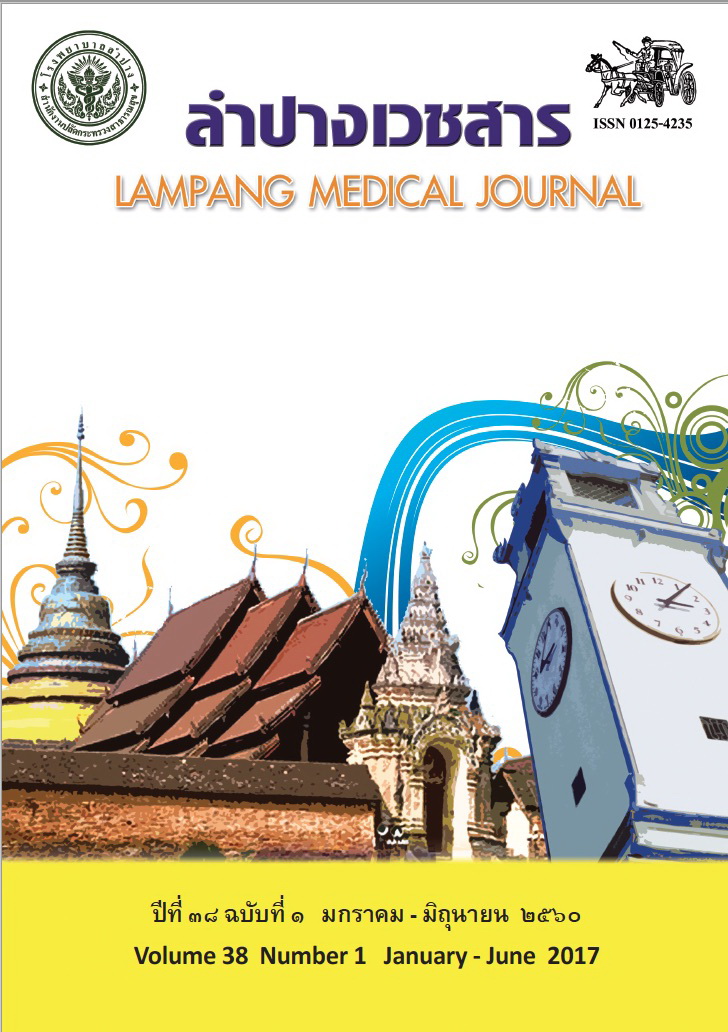Improving Surgeons’ Intraoperative Estimation of Stem Anteversion for Hip Arthroplasty by Using Digital Protractor: a Preliminary Report
Main Article Content
Abstract
Background: Conventional technique for estimating femoral stem anteversion intraoperatively during hip arthroplasty by surgeon visualization is proven to be inaccurate.
Objective: To determine the accuracy of a new technique of using digital protractor for improving surgeons’ intraoperative estimation of stem anteversion.
Material and method: A prospective observational study was conducted on 69 patients with femoral neck fracture and OA hip who underwent hemi-arthroplasty and total hip arthroplasty in Lampang Hospital during January 2016 and March 2017. The intra-operative femoral stem anteversion was measured by placing a digital protractor to the femoral broach during the assistant hold the leg in the truly vertical position and compared with the anteversion angle
measured in CT scan postopertively. Percentage of the stems having postoperative anteversion angle different from intra-operatively measured angle within 5o was calculated and analyzed for correlation with clinical data by using regression analysis.
Results: Most of the patients were female (62.3%) with the mean age of 63.6 ± 13.8 years (rage, 21-91). Most of diagnoses were femoral neck fracture (59.4%) and osteonecrosis of femoral head (20.3%).Total hip arthroplasty was performed in 55.1% and posterolateral approach was used in 75.4 % of the patients. In posterolateral approach group, the difference between intra-operative and postoperative angle was -0.1o ± 4.2o (p=0.895) and 80.8 % of stems had <5o
of difference. In direct lateral approach group, the average difference was -2.7o ± 10.3o (p=0.313) and 47.1% of stems had <5o of difference.
Conclusion: Using digital protractor for intraoperative estimation of stem anteversion had high
accuracy within 5o of errors for posterolateral approach.
Article Details
บทความที่ส่งมาลงพิมพ์ต้องไม่เคยพิมพ์หรือกำลังได้รับการพิจารณาตีพิมพ์ในวารสารอื่น เนื้อหาในบทความต้องเป็นผลงานของผู้นิพนธ์เอง ไม่ได้ลอกเลียนหรือตัดทอนจากบทความอื่น โดยไม่ได้รับอนุญาตหรือไม่ได้อ้างอิงอย่างเหมาะสม การแก้ไขหรือให้ข้อมูลเพิ่มเติมแก่กองบรรณาธิการ จะต้องเสร็จสิ้นเป็นที่เรียบร้อยก่อนจะได้รับพิจารณาตีพิมพ์ และบทความที่ตีพิมพ์แล้วเป็นสมบัติ ของลำปางเวชสาร
References
2. van Embden D, van Gijn W, van de Steenhoven T, Rhemrev S. The surgeon’s eye: a prospective analysis of the anteversion in the placement of hemiarthroplasties after a femoral neck fracture. Hip Int 2015;25:127-30.
3. Dorr LD, Wan Z, Malik A, Zhu J, Dastane M, Deshmane P. A comparison of surgeon estimation and computed tomographic measurement of femoral component anteversion in cementless total hip arthroplasty. J Bone Joint Surg Am 2009;91:2598-604.
4. Gill HS, Alfaro-Adricn J, Alfaro-Adricn C, McLardy-Smith P, Murray DW. The effect of anteversion on femoral component stability assessed by radiostereometric analysis.
J Arthroplasty 2002;17:997-1005.
5. Wines AP, McNicol D. Computed tomography measurement of the accuracy of component version in total hip arthroplasty. J Arthroplasty 2006;21:696-701.
6. Hirata M, Nakashima Y, Ohishi M, Hamai S, Hara D, Iwamoto Y. Surgeon error in performing intraoperative estimation of stem anteversion in cementless total hip arthroplasty. J Arthroplasty 2013;28:1648-53.
7. Meermans G, Goetheer-Smits I, Lim RF, Van Doorn WJ, Kats J. The difference between the radiographic and the operative angle of inclination of the acetabular component in total hip arthroplasty: use of a digital protractor and the circumference of the hip to improve orientation. Bone Joint J 2015;97-B:603-10.
8. Sykes AM, Hill JC, Beverland DE, Orr JF. A novel device to measure acetabular inclinaton with patents in lateral decubitus. Hip Int 2012; 22:683-9.


